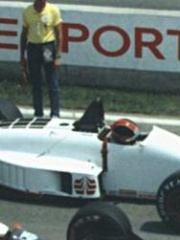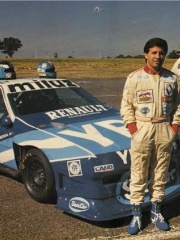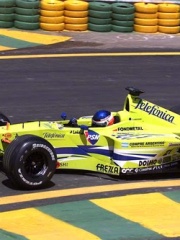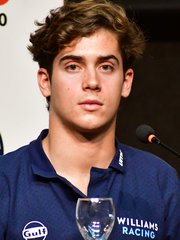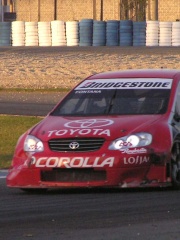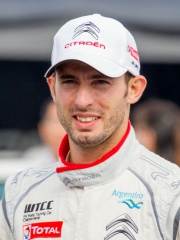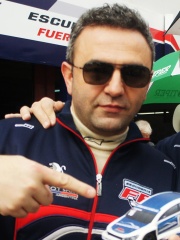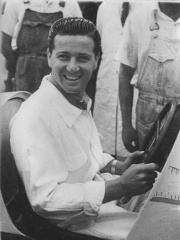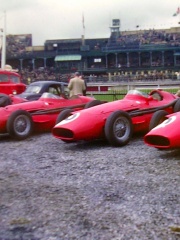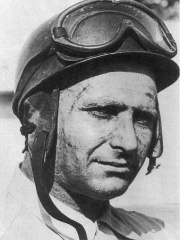
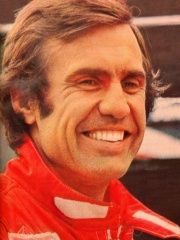

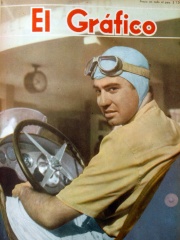
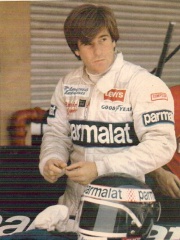
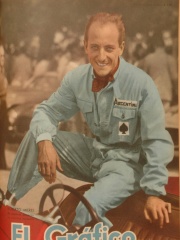
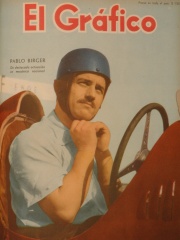

The Most Famous
RACING DRIVERS from Argentina
This page contains a list of the greatest Argentinean Racing Drivers. The pantheon dataset contains 1,080 Racing Drivers, 28 of which were born in Argentina. This makes Argentina the birth place of the 11th most number of Racing Drivers behind Switzerland, and Finland.
Top 10
The following people are considered by Pantheon to be the top 10 most legendary Argentinean Racing Drivers of all time. This list of famous Argentinean Racing Drivers is sorted by HPI (Historical Popularity Index), a metric that aggregates information on a biography's online popularity. Visit the rankings page to view the entire list of Argentinean Racing Drivers.

1. Juan Manuel Fangio (1911 - 1995)
With an HPI of 77.85, Juan Manuel Fangio is the most famous Argentinean Racing Driver. His biography has been translated into 70 different languages on wikipedia.
Juan Manuel Fangio (Spanish: [ˈxwan maˈnwel ˈfaŋxjo], Italian: [ˈfandʒo]; 24 June 1911 – 17 July 1995) was an Argentine racing driver, who competed in Formula One from 1950 to 1958. Nicknamed "el Chueco" and "el Maestro", Fangio won five Formula One World Drivers' Championship titles and—at the time of his retirement—held the record for most wins (24), pole positions (29), fastest laps (23), and podium finishes (35), among others. From childhood, Fangio abandoned his studies to pursue auto mechanics. In 1938, he debuted in the newly-formed Argentine stock car racing series Turismo Carretera, competing in a Ford V8. In 1940, he competed with Chevrolet, winning the Grand Prix International Championship and devoted his time to the Turismo Carretera becoming its champion, a title he successfully defended a year later. Fangio then competed in Europe between 1947 and 1949, where he achieved further success. One of the most successful drivers in Formula One history, Fangio made his debut in the inaugural Formula One season in 1950 to dominate the first decade of the championship. He went on to win the World Drivers' Championship five times—a record that stood for 46 years—and became the only driver in F1 history to win titles with four different teams: Alfa Romeo (1951), Maserati (1954 and 1957), Mercedes-Benz (1954 and 1955), and Ferrari (1956). He holds the highest winning percentage in Formula One at 46.15%, winning 24 of 52 Formula One races he entered. Additionally, Fangio also holds the record for the highest pole percentage at 55.77%, achieving 29 pole positions from 52 entries. Fangio is the only Argentine driver to have won the World Drivers' Championship and the Argentine Grand Prix. He also competed in sports car racing, winning the 12 Hours of Sebring in 1956 with Ferrari and in 1957 with Maserati. After retirement, Fangio presided as the honorary president of Mercedes-Benz Argentina from 1987, a year after the inauguration of his museum, until his death in 1995. In 2011, on the centenary of his birth, Fangio was remembered around the world and various activities were held in his honor.

2. Carlos Reutemann (1942 - 2021)
With an HPI of 69.28, Carlos Reutemann is the 2nd most famous Argentinean Racing Driver. His biography has been translated into 37 different languages.
Carlos Alberto "Lole" Reutemann (12 April 1942 – 7 July 2021) was an Argentine racing driver and politician, who competed in Formula One from 1972 to 1982 and served as the Governor of Santa Fe from 1999 to 2003. Reutemann was runner-up in the Formula One World Drivers' Championship in 1981 with Williams and—at the time of his retirement—held the record for most podium finishes (45); he won 12 Grands Prix across 11 seasons. A member of the Justicialist Party, he was a National Senator for Santa Fe from 2003 until his death in 2021. As a racing driver, Reutemann was among Formula One's leading protagonists between 1972 and 1982. He scored 12 Grand Prix wins and six pole positions. In 1981 while driving for Williams he finished second in the World Drivers' Championship by one point, having been overtaken in the last race of the season. Reutemann also finished in third overall three times for three separate teams, 1975 for Brabham, 1978 for Ferrari, and 1980 for Williams. To date, he is the last Argentine driver to win a Grand Prix. In terms of race wins, Reutemann's final Ferrari season in 1978 was his most successful with four wins, but he fell short to the consistency of the Lotus team with Mario Andretti and Ronnie Peterson and was not in championship contention to the final race. He finished third, just behind Peterson, who had died in an accident at Monza earlier that autumn. In 1981, Reutemann instead relied on consistency, but narrowly lost out to Nelson Piquet for the title. He became the second Formula One driver after Leo Kinnunen to be at the podium of a World Rally Championship event, when he finished third in the 1980 and 1985 editions of Rally Argentina. He was also for three decades the only Formula One driver to score drivers' championship points in both F1 and WRC, until Kimi Räikkönen's eighth place at the 2010 Jordan Rally. As a popular governor and a senator, Reutemann was considered by some, on several occasions, to be a worthy candidate for president of Argentina. While he considered running for president in the 2011 Argentine general election, he ultimately declined to do so. Reutemann died in a medical facility in Santa Fe, Argentina, on 7 July 2021 after suffering from issues relating to a haemorrhage as well as other health issues.

3. José Froilán González (1922 - 2013)
With an HPI of 64.52, José Froilán González is the 3rd most famous Argentinean Racing Driver. His biography has been translated into 31 different languages.
José Froilán González (5 October 1922 – 15 June 2013) was an Argentine racing driver who competed in Formula One between 1950 and 1960. Nicknamed "the Pampas Bull" and "el Cabezón", González was runner-up in the Formula One World Drivers' Championship in 1954 with Ferrari, and won two Grands Prix across nine seasons. In endurance racing, González won the 24 Hours of Le Mans in 1954, also with Ferrari. González, who was a close friend of Juan Manuel Fangio and Roberto Mieres, among others, is particularly notable for scoring Ferrari's first win in a Formula One World Championship race at the 1951 British Grand Prix. He made his Formula One debut for Scuderia Achille Varzi in the 1950 Monaco Grand Prix. His last Grand Prix was the 1960 Argentine Grand Prix. González competed in 26 World Championship Formula One Grands Prix over nine seasons (1950–1957 and 1960) and numerous non-Championship events. In the 26 World Championship races, González scored two victories (the 1951 British Grand Prix and the 1954 British Grand Prix), seven second-place finishes, six third-place finishes, three pole positions, six fastest laps, and 72 1⁄7 points. He won the 1951 Coppa Acerbo, the 1954 24 Hours of Le Mans with Maurice Trintignant, and the Portuguese Grand Prix for Ferrari.

4. Onofre Marimón (1923 - 1954)
With an HPI of 61.89, Onofre Marimón is the 4th most famous Argentinean Racing Driver. His biography has been translated into 21 different languages.
Onofre Agustín Marimón (19 December 1923 – 31 July 1954) was an Argentine racing driver, who competed in Formula One at 12 Grands Prix between 1951 and 1954. Marimón participated in 12 Formula One Grands Prix, achieving two podiums at the 1953 Belgian and 1954 British Grands Prix, and scoring a total of 8 1⁄7 championship points with Maserati. He also won the non-championship 1954 Rome Grand Prix, driving the Maserati 250F. During practice for the 1954 German Grand Prix at the Nürburgring, Marimón died after losing control of his Maserati 250F, impacting a ditch and causing a rollover. He was the first fatality at a Formula One Grand Prix.
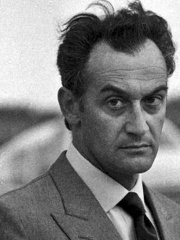
5. Alejandro de Tomaso (1928 - 2003)
With an HPI of 60.40, Alejandro de Tomaso is the 5th most famous Argentinean Racing Driver. His biography has been translated into 20 different languages.
Alejandro de Tomaso (10 July 1928 in Buenos Aires – 21 May 2003 in Modena, Italy) was an Argentine racing driver and businessman. His name is sometimes seen in an Italianised form as Alessandro de Tomaso. He participated in two Formula One World Championship Grands Prix, debuting on 13 January 1957. He scored no championship points. He later founded the Italian sports car company De Tomaso Automobili in 1959.

6. Ricardo Zunino (b. 1949)
With an HPI of 58.95, Ricardo Zunino is the 6th most famous Argentinean Racing Driver. His biography has been translated into 23 different languages.
Ricardo Héctor Zunino (born 13 April 1949) is an Argentine retired racing driver who participated in Formula One from 1979 to 1981. He competed in 11 World Championship races and two non-Championship Formula One races, the 1980 Spanish Grand Prix and 1981 South African Grand Prix. At the 1979 Canadian Grand Prix, Zunino replaced Niki Lauda at Brabham after the Austrian abruptly quit the team and Formula One. Zunino, attending the race as a spectator on a weekend off from his regular British F1 Championship drive, was chosen to take over the seat, having recently tested for the team. After the 1980 French Grand Prix he was replaced by Héctor Rebaque. In Argentina, Zunino was two-time Turismo Nacional champion, with Fiat.

7. Roberto Mieres (1924 - 2012)
With an HPI of 57.00, Roberto Mieres is the 7th most famous Argentinean Racing Driver. His biography has been translated into 19 different languages.
Roberto Casimiro Mieres Dasso (3 December 1924 – 26 January 2012) was a racing driver from Mar del Plata, Argentina. He participated in 17 Formula One World Championship Grands Prix, debuting on 7 June 1953. He scored a total of 13 championship points.

8. Pablo Birger (1924 - 1966)
With an HPI of 56.79, Pablo Birger is the 8th most famous Argentinean Racing Driver. His biography has been translated into 18 different languages.
Pablo Birger (7 January 1924 – 9 March 1966) was an Argentine racing driver who raced in two World Championship Grands Prix for the Gordini team. He raced a Gordini Type 15 in the 1953 Argentine Grand Prix but the car lasted just twenty-one laps. Two years later, he again rented a seat with Gordini, this time racing a Type 16, but spun on the first lap and collided with Carlos Menditeguy. Birger, who was born in Buenos Aires, died in a road accident in his native city at the age of 42.

9. Roberto Bonomi (1919 - 1992)
With an HPI of 56.57, Roberto Bonomi is the 9th most famous Argentinean Racing Driver. His biography has been translated into 19 different languages.
Roberto Wenceslao Bonomi Oliva (30 September 1919 in Buenos Aires, Argentina – 10 January 1992) was a racing driver who took part in one Formula One World Championship Grand Prix driving a Cooper for the Scuderia Centro Sud team. Before he participated in Formula One he was a sports car champion in 1952 and 1953, as well as a member of the Argentine team to race in Europe. Bonomi worked as a local politician and landowner.
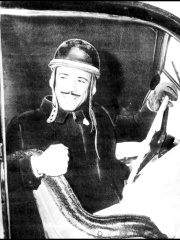
10. Oscar Alfredo Gálvez (1913 - 1989)
With an HPI of 56.42, Oscar Alfredo Gálvez is the 10th most famous Argentinean Racing Driver. His biography has been translated into 22 different languages.
Oscar Alfredo Gálvez (17 August 1913 – 16 December 1989) was an Argentine racing driver, known best for participating – and for scoring two championship points – in the Formula One World Championship Grand Prix on 18 January 1953.
People
Pantheon has 28 people classified as Argentinean racing drivers born between 1911 and 2003. Of these 28, 8 (28.57%) of them are still alive today. The most famous living Argentinean racing drivers include Ricardo Zunino, Oscar Larrauri, and Miguel Ángel Guerra. The most famous deceased Argentinean racing drivers include Juan Manuel Fangio, Carlos Reutemann, and José Froilán González. As of April 2024, 1 new Argentinean racing drivers have been added to Pantheon including Franco Colapinto.
Living Argentinean Racing Drivers
Go to all RankingsRicardo Zunino
1949 - Present
HPI: 58.95
Oscar Larrauri
1954 - Present
HPI: 55.22
Miguel Ángel Guerra
1953 - Present
HPI: 52.15
Gastón Mazzacane
1975 - Present
HPI: 50.38
Franco Colapinto
2003 - Present
HPI: 49.57
Norberto Fontana
1975 - Present
HPI: 46.99
José María López
1983 - Present
HPI: 45.73
Esteban Tuero
1978 - Present
HPI: 44.27
Deceased Argentinean Racing Drivers
Go to all RankingsJuan Manuel Fangio
1911 - 1995
HPI: 77.85
Carlos Reutemann
1942 - 2021
HPI: 69.28
José Froilán González
1922 - 2013
HPI: 64.52
Onofre Marimón
1923 - 1954
HPI: 61.89
Alejandro de Tomaso
1928 - 2003
HPI: 60.40
Roberto Mieres
1924 - 2012
HPI: 57.00
Pablo Birger
1924 - 1966
HPI: 56.79
Roberto Bonomi
1919 - 1992
HPI: 56.57
Oscar Alfredo Gálvez
1913 - 1989
HPI: 56.42
Clemar Bucci
1920 - 2011
HPI: 56.27
Carlos Menditeguy
1914 - 1973
HPI: 56.17
Jorge Daponte
1923 - 1963
HPI: 55.64
Newly Added Argentinean Racing Drivers (2025)
Go to all RankingsOverlapping Lives
Which Racing Drivers were alive at the same time? This visualization shows the lifespans of the 20 most globally memorable Racing Drivers since 1700.

